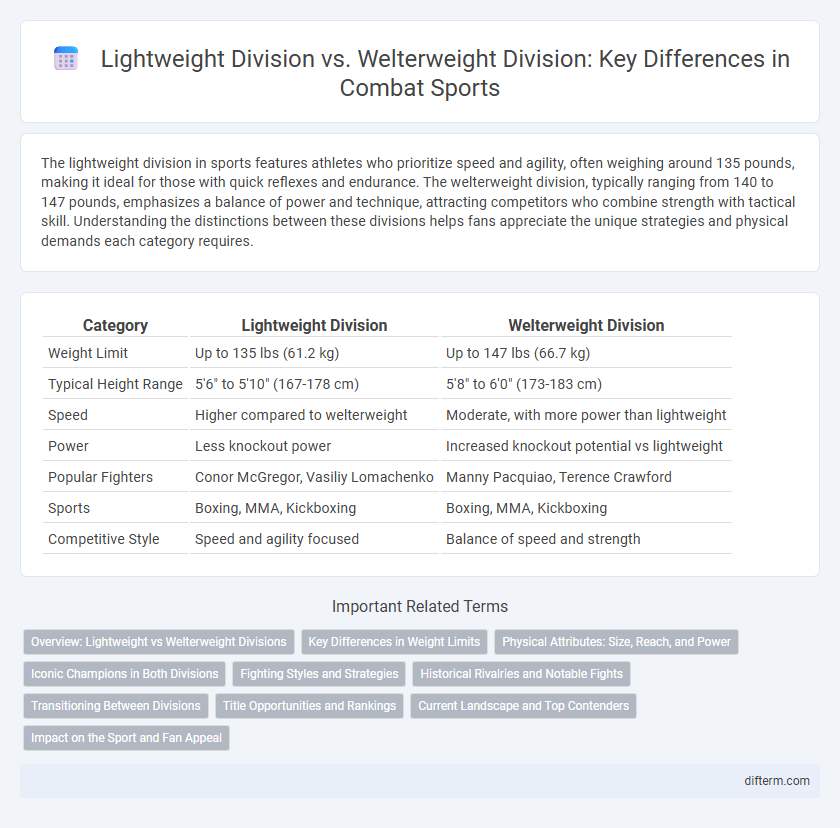The lightweight division in sports features athletes who prioritize speed and agility, often weighing around 135 pounds, making it ideal for those with quick reflexes and endurance. The welterweight division, typically ranging from 140 to 147 pounds, emphasizes a balance of power and technique, attracting competitors who combine strength with tactical skill. Understanding the distinctions between these divisions helps fans appreciate the unique strategies and physical demands each category requires.
Table of Comparison
| Category | Lightweight Division | Welterweight Division |
|---|---|---|
| Weight Limit | Up to 135 lbs (61.2 kg) | Up to 147 lbs (66.7 kg) |
| Typical Height Range | 5'6" to 5'10" (167-178 cm) | 5'8" to 6'0" (173-183 cm) |
| Speed | Higher compared to welterweight | Moderate, with more power than lightweight |
| Power | Less knockout power | Increased knockout potential vs lightweight |
| Popular Fighters | Conor McGregor, Vasiliy Lomachenko | Manny Pacquiao, Terence Crawford |
| Sports | Boxing, MMA, Kickboxing | Boxing, MMA, Kickboxing |
| Competitive Style | Speed and agility focused | Balance of speed and strength |
Overview: Lightweight vs Welterweight Divisions
The lightweight division typically includes fighters weighing up to 155 pounds, known for their speed, agility, and technical precision, while the welterweight division encompasses competitors up to 170 pounds, blending power with endurance and tactical versatility. Lightweight bouts often emphasize rapid combinations and quick footwork, contrasting with the welterweight's balance of strength and stamina that can result in more strategic matchups. Both divisions showcase elite athleticism but differ fundamentally in fighting style, physicality, and competitive dynamics, shaping how athletes prepare and perform in high-stakes contests.
Key Differences in Weight Limits
The lightweight division in sports typically ranges from 135 to 155 pounds, while the welterweight division spans from 147 to 170 pounds, reflecting a significant difference in weight limits. This weight gap influences fighters' speed, power, and endurance, with lightweight athletes often excelling in agility and quickness. Welterweights generally have greater strength and durability, making these divisions distinct in competitive strategy and physical demands.
Physical Attributes: Size, Reach, and Power
Lightweight division fighters typically weigh up to 155 pounds, showcasing a balance of speed and agility, while welterweights weigh up to 170 pounds, emphasizing greater power and strength. Reach differences are notable; welterweights often have a longer reach, enhancing their striking range and defensive capabilities. The power discrepancy stems from the increased muscle mass in welterweights, resulting in heavier strikes compared to the quicker but less forceful impacts of lightweights.
Iconic Champions in Both Divisions
Lightweight division legends like Roberto Duran and Pernell Whitaker set unparalleled standards with their agility and technical skill, while welterweight icons such as Sugar Ray Leonard and Floyd Mayweather Jr. showcase strategic prowess and power. Both divisions have produced champions who transcended their weight classes, capturing global attention and influencing boxing's evolution. Their distinct styles and historic bouts continue to define the rich legacy of competitive excellence in combat sports.
Fighting Styles and Strategies
The lightweight division typically features fighters relying on speed, agility, and technical precision, utilizing quick combinations and evasive footwork to outmaneuver opponents. In contrast, the welterweight division emphasizes a balance of power and endurance, where fighters often adopt a more aggressive approach, blending strong striking with effective clinch work and ground control. Both divisions demand strategic adaptability, but the lightweight style prioritizes rapid movement and volume striking, while welterweights focus on strength, resilience, and calculated pressure.
Historical Rivalries and Notable Fights
The lightweight division has showcased legendary rivalries such as the epic battles between Roberto Duran and Jose Luis Ramirez, which highlighted speed and technical skill. In contrast, the welterweight division boasts iconic clashes like Sugar Ray Leonard vs. Thomas Hearns, famous for power and aggressive tactics. Both divisions have shaped boxing history through intense matchups that emphasized distinct fighting styles and competitive legacies.
Transitioning Between Divisions
Transitioning between the lightweight and welterweight divisions involves significant adjustments in weight management, training intensity, and fight strategy to optimize performance. Fighters moving up from lightweight (155 lbs) to welterweight (170 lbs) often encounter opponents with greater power and size, requiring enhanced strength conditioning and defensive techniques. Conversely, moving down demands careful dieting and endurance focus to maintain speed and stamina without sacrificing muscle mass or energy levels.
Title Opportunities and Rankings
The lightweight division often features a larger pool of top contenders, resulting in more frequent title opportunities and rapid shifts in rankings due to intense competition. Welterweight division rankings tend to be more stable, with title shots awarded based on consistent wins and established fighters maintaining dominance. Both divisions require strategic navigation of rankings and high-profile wins to secure championship bouts.
Current Landscape and Top Contenders
The lightweight division remains highly competitive with top contenders like Islam Makhachev and Charles Oliveira showcasing dynamic grappling and striking skills. In the welterweight division, stars such as Kamaru Usman and Leon Edwards dominate with powerful stand-up and strategic ground control. Both divisions feature intense matchups and evolving talent pools that drive significant fan engagement and championship title implications.
Impact on the Sport and Fan Appeal
The lightweight division, known for its speed and technical precision, often delivers fast-paced, high-action bouts that captivate fans with nonstop excitement, significantly boosting viewership and engagement. In contrast, the welterweight division combines power and agility, producing a balance of knockout potential and endurance that appeals to a broader audience, enhancing the sport's marketability and global reach. Together, these divisions contribute to the sport's diversity, attracting varied fan demographics and increasing overall popularity and commercial success.
lightweight division vs welterweight division Infographic

 difterm.com
difterm.com